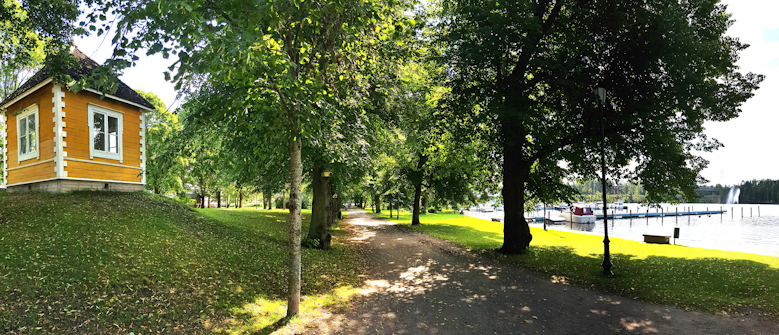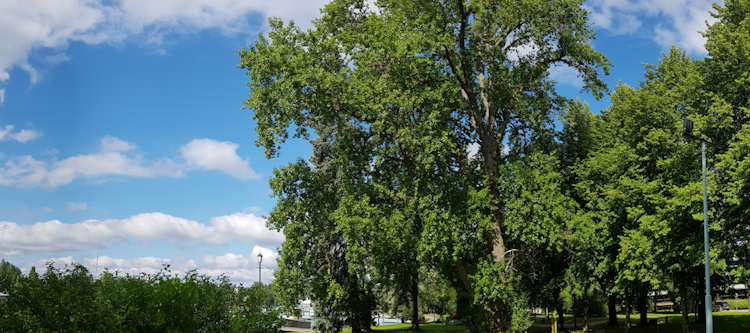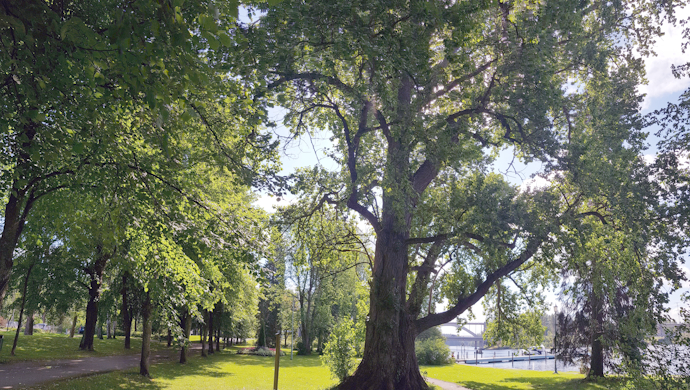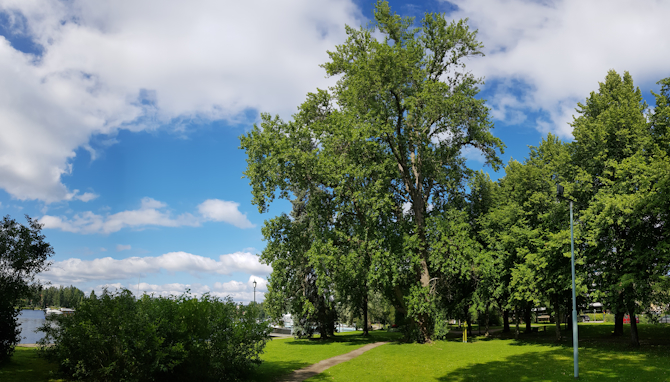The largest tree in Finland stretches its long branches over the waterside park at Heinola. This famous tree is called Tsaarinpoppeli (Czar’s Poplar tree in English), and it has survived floods and devastation for hundreds of years. We were passing through Heinola and decided to stop for an ice-cream and a stroll under the massive canopy of this Tsaarinpoppeli.
This enormous tree has seven massive main branches, each of which could be their own tree. Specialists estimate that the Tsaarinpoppeli at Heinola is something from 130–180 years old. Sadly, it’s not safe to take a sample of this huge poplar tree and date it by using dendrochronology (also known as tree-ring dating). If the bark was damaged, mold or other pest might gain access to the core of the tree.
Tsaarinpoppeli is a poplar tree that has been morphed into the specific species that now stands at Heinola. For those into Latin terminology, the species of Tsaarinpoppeli is Populus ×petrowskiana. When it was last measured with a laser scan in 2011, this massive poplar tree was 34,5m (115ft) tall, its canopy circumference was 23m (75ft), and the circumference of the trunk was 6,37m (21ft). Since the tree continues to thrive and grow, it’s likely that it’s grown even bigger. In fact, the tree is so huge it was difficult to get a picture of it no matter how far I walked!
Historical roots of Heinola and Tsaarinpoppeli
Heinola is a city situated next to the great Kymijoki river. Heinola is a historical grid-square city, which began as a municipal centre and a famous spa area. The plans of Heinola were made in 1779, which is when Finland was still a part of Sweden. Only a few decades later, Finland became a part of Russia after Sweden lost the Finnish war. For those needing a refresher course, the Finnish war was fought between the Kingdom of Sweden and the Russian Empire from February 1808 to September 1809 as part of the Napoleonic Wars.
The Kymijoki river running next to Heinola has its origin at Päijänne lake, which is Finland’s second largest lake at 1100km² (425mi²). The proximity of Kymijoki river is important to the story of Tsaarinpoppeli because it alone survived the great flood of 1901. This is when the water level of Kymijoki rose all the way to the main market square of Heinola. All the other tree saplings planted at the riverside park called Rantapuisto when it was established in 1892 were swept off except for one. These saplings had been special, too, since they had been especially chosen by the Russian Czar. However, the tree we now know as Tsaarinpoppeli survived. And not only did Tsaarinpoppeli survive – it thrived!


Today, this particular Tsaarinpoppeli remains an important symbol for the people of Heinola. The tree has participated in light installations in the dead of winter, and when its leaves open, the tree itself becomes a sight to wonder. The Rantapuisto park is called the “summer living room” of the residents of Heinola, where even the hottest day can be leisurely spent under the cooling leafy canopies.
Directions to Tsaarinpoppeli
Address: You can type Tsaarinpoppeli in your navigator. Alternatively, you can also type in Torikatu 2, 18100 Heinola.
How to get there:
- Car: There is limited parking at the centre of Heinola.
- Bicycle: The Päijänne lake area is incredibly lush and beautiful to cycle along.
- Public transport: You can get to Heinola by public transport. Type Tsaarinpoppeli or Heinola on the Route Planner for timetables.
Accessibility: The Rantapuisto park area is accessible all year long.
When to go: You can visit at any time of the year.
Facilities: There are no official facilities in the area. However, the Heinola city centre is right next to the tree.
Make sure you also check out
Make sure to check the most beautiful tree in Finland by visiting Paavola oak.



